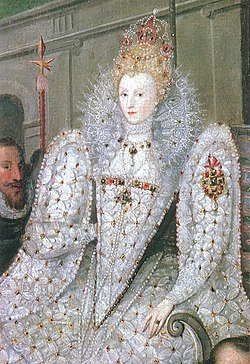Stuartkragen

Stuartkragen oder Medicikragen nannte man eine Kragenform für Damen, die Ende des 16. bis ins frühe 17. Jahrhundert in Mode war.
Der vom Dekolleté ausgehende Kragen steht fächerförmig im Nacken hoch und wurde durch eingezogene Drähte verstärkt; er bestand häufig aus kostbarer venezianischer Spitze. Er war vor allem in Frankreich, England und in den Niederlanden gebräuchlich.
Der Stuartkragen wurde fälschlicherweise nach der schottischen Königin Maria Stuart benannt, die häufig diese Art von Kragen getragen haben soll. Medicikragen bezieht sich entsprechend auf Maria von Medici, wobei diese Kragenform im Gegensatz zum Stuartkragen noch höher aufragt.
- Louise de Lorraine, ca. 1580. Ein in plissierte Falten gelegter Kragen.
- Robert Peake (?): Elisabeth I. in einer Prozession, um 1600 (Detail)
- John de Critz (?): Anne von Dänemark, um 1605. Eine glatte Variante mit viel Spitze zum runden Ausschnitt.
- Rubens (?): Charlotte-Marguerite de Montmorency, (1594–1650). Die Maitresse Heinrichs IV. trägt eine sehr einfache Variante des Medicikragens.
- Anthonis van Dyck: Marie Louise de Tassis, um 1630.
- Élisabeth Vigée-Lebrun: Luise von Preußen, 1801. Im Empire um 1800 wird wieder ein ähnlicher Stehkragen modern.
Weblinks
Auf dieser Seite verwendete Medien
Anne de Danemark (1574-1619), reine d'Angleterre
This portrait was commissioned to Frans Pourbus the Younger, Maria de' Medici's court painter, by her aunt, Grand Duchess Christina of Lorraine. A portrait of the reigning king – Louis XIII, Maria's son – of the same dimensions was commissioned too, but wrongly Pourbus painted a matching portrait of Henri IV, the Queen's husband. Because of its high quality, they decided to keep the portrait of the late King. This two versions decorated for years Palazzo Pitti's apartements, where they still are; two other versions in 1613 for the «series of the most serene princes», now called «serie aulica», a collection of portraits of the most important members of the House of Medici (placed at Uffizi Gallery's corridors)
Porträt der Charlotte-Marguerite de Montmorency (1594-1650), Ehefrau von Henri II. de Bourbon, prince de Condé (1588-1646)
Lot Essay: "A reduced but early copy of the portrait in the Frick Museum, Pittsburgh, see H. Vlieghe, Corpus Rubenianum, Ludwig Burchard, Part XIX, Portraits, 1988, no. 86, who lists two other copies.The added inscription confirms Burchards's supposition which was later validated by a reference to the Frick picture in a Legané collection inventory of 1642. Vlieghe following Burchard, however dated the picture to c.1610. The sitter who died in 1650, married Henri II de Bourbon, Prince of Condé in 1609; the couple stayed at the Archducal court in Brussels in 1609-10, as Vlieghe records." [1]
Porträt der Louise de Lorraine-Vaudémont (1553-1601), Ehefrau von Heinrich III. (1551-1589)












